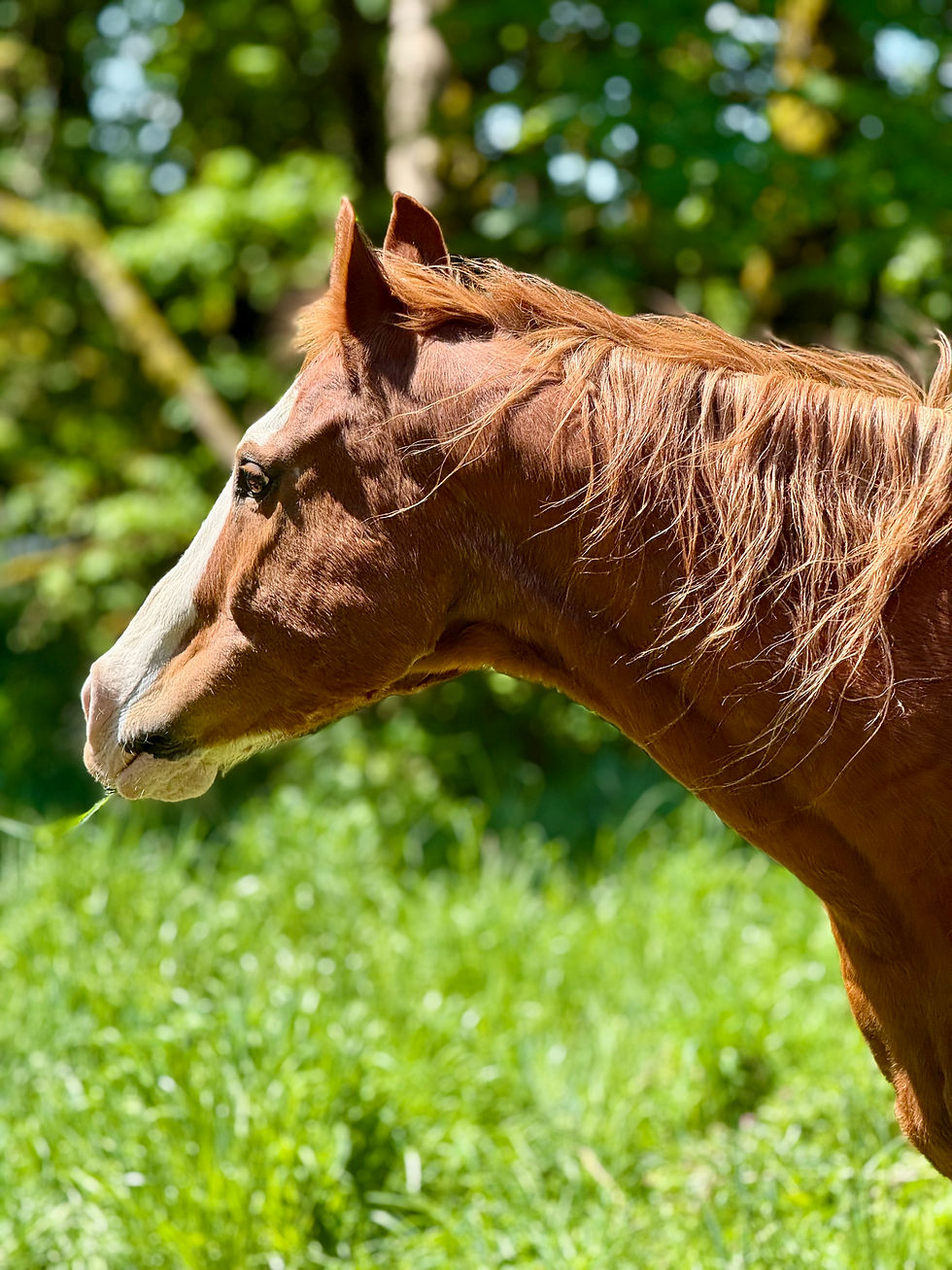What Is PSSM1 in Horses? A Complete Guide to Causes, Symptoms, and Care
- gabriellarson751
- Jun 17
- 3 min read
Updated: Aug 6
Polysaccharide Storage Myopathy Type 1 (PSSM1) is a genetic muscle disorder that affects thousands of horses across a wide range of breeds. It’s one of the most commonly diagnosed muscle conditions in horses—particularly in stock-type breeds like Quarter Horses, Paints, and Appaloosas.
If you’re a horse owner, breeder, or rider, understanding PSSM1 is critical. With the right knowledge and management, horses with PSSM1 can continue to live active, healthy, and even competitive lives.
What Exactly Is PSSM1?
PSSM1 is a heritable metabolic condition caused by a mutation in the GYS1 gene. This gene controls the activity of glycogen synthase, the enzyme responsible for converting glucose into glycogen for energy storage in muscles.
In horses with PSSM1, this enzyme is overactive—leading to the excessive and abnormal accumulation of glycogen and a structurally unusual polysaccharide in muscle tissue. While glycogen is a necessary fuel for muscle contraction, this buildup becomes problematic, especially during exercise or periods of stress. The result? Pain, stiffness, and performance issues.
Which Breeds Are Affected?
PSSM1 has been identified in more than 20 breeds, but is most common in:
Quarter Horses and related breeds
Draft breeds (e.g., Belgians, Percherons)
Warmbloods (although they are more commonly affected by PSSM2)
Signs and Symptoms of PSSM1
Clinical signs typically appear between 2 and 5 years of age, though the onset and severity can vary depending on diet, workload, and genetics. Common symptoms include:
Muscle stiffness or cramping, especially in the hindquarters
Reluctance to move, or signs of tying-up (exertional rhabdomyolysis)
Excessive sweating with minimal work
Stiff or abnormal gait
Shifting leg lameness or reluctance to lie down or get up
In severe cases: inability to move, or colic-like symptoms due to muscle pain
Some horses only show intermittent or mild symptoms, which can make diagnosis tricky without genetic testing.
How Is PSSM1 Diagnosed?
There are two primary methods:
Genetic TestingA simple DNA test using mane or tail hair confirms the GYS1 mutation. This is the gold standard for diagnosing PSSM1.
Muscle BiopsyIn select cases, a muscle biopsy may be performed to identify abnormal polysaccharide storage—particularly when ruling out other types of myopathies.
Managing PSSM1: Diet and Exercise
While there’s no cure, horses with PSSM1 can thrive when properly managed. Success hinges on a consistent low-sugar diet and regular exercise.
Nutritional Guidelines
Managing PSSM1 starts in the feed room. Focus on:
Low-NSC (non-structural carbohydrate) diets
Avoiding grains, sweet feeds, and high-starch concentrates
Adding fat as a calorie source (e.g., vegetable oil, flaxseed, rice bran)
Supplementing Vitamin E and Selenium for muscle support
Exercise and Turnout
Daily movement helps reduce muscle glycogen buildup and improves energy utilization:
Prioritize daily turnout or light activity
Avoid extended stall rest
Implement a gradual conditioning plan for fitness and strength
Monitoring Health
Periodic bloodwork to monitor muscle enzymes
Regular check-ins with a veterinarian and equine nutritionist to fine-tune the horse’s program
Breeding and Genetic Risk
PSSM1 is inherited in a dominant pattern, meaning a horse only needs one copy of the gene to be affected. Breeding should be approached with caution, and genetic testing is essential before making breeding decisions.
How Horse Armor Nutrition Can Help
At Horse Armor Nutrition, we’ve experienced PSSM1 firsthand. One of our own horses was diagnosed with PSSM1, and that sparked a deeper commitment to equine health. We pursued a certification in Equine Nutrition from Rutgers University to offer real, science-backed support to horse owners facing challenges like this.
Our PSSM1 feeding strategy includes:
Teff hay as a low-NSC forage
Low-starch concentrates like Nutrena SafeChoice Special Care
Prolyte + E, our powerful Vitamin E supplement, for muscle recovery and antioxidant support
An Amino Acid Electrolyte for improved muscle function and hydration
A joint supplement for horses whose symptoms have impacted soft tissues or joint health
Our Mission
We created Horse Armor Nutrition to give better resources and smarter solutions to horse owners. Whether you're managing a horse with PSSM1 or looking to prevent future issues, we're here to help with honest guidance and proven products.
Got questions? We’re just a message away. Let us help you.

_edited.png)




Comments